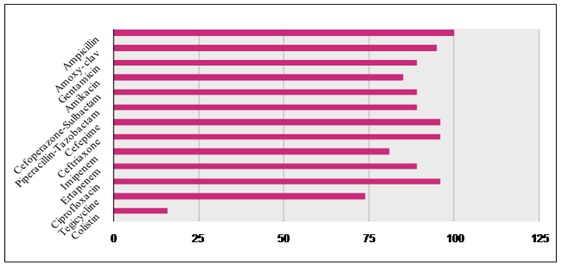Antibiogram of Klebsiella pneumoniae isolated from various clinical samples of hospitalized patients in a tertiary care hospital of North India
Abstract
Background: Klebsiella pneumoniae is an important cause of nosocomial and community acquired infections worldwide. It exhibits high antibiotic resistance due to production of Extended Spectrum Beta Lactamases (ESBLs) and Carbapenamases. The aim of present study was to know its resistance pattern of Klebsiella pneumoniae so as to help local physicians choose appropriate antibiotics for effective infection control.
Materials and Methods: It was a prospective study carried out from January 2019 to July 2019 in the department of Microbiology of a tertiary care hospital in North India. The study comprised of a total of 194 non-repeat isolates obtained from various clinical samples received in Microbiology lab for culture & sensitivity testing. All isolates were processed to determine their antimicrobial sensitivity profile. For data analysis SPSS software, version 17.0 and MS excel 2007 were used.
Results: Out of total 2155 (22.43%) positive cultures 194 (9%) isolates were that of Klebsiella pneumoniae Most of the isolates obtained were multi-drug resistant, ESBL and Carbapenamase producers. 100% isolates showed resistance to Ampicillin.
Conclusion: Since the frequency of multiple drug resistance among Klebsiella pneumoniae is alarmingly high, therefore periodic monitoring of antimicrobial susceptibility profile of these agents is much needed. This will help physician in selection of appropriate chemotherapy and thus help in effective management of the infections and better patient care.
Downloads
References
2. Winn WC. Koneman's color atlas and textbook of diagnostic microbiology. Lippincott williams&wilkins; 2006.
3. Arti Kapil. Ananthanarayan & Paniker s Textbook of Microbiology. 9thed. Chennai: Universities PressPvt Ltd, 2013.
4. Patrick R Murray, Barry Holmes, HazelM. Aucken. Topley & Wilson’s Microbiology & Microbial Infections. Volume 2. 10th edition. Salisbury, UK: Edward Arnold Ltd 2005.
5. Kang HY, Jeong YS, Oh JY, Tae SH, Choi CH, Moon DC, et al. Characterization of antimicrobial resistance and class 1 integrons found in Escherichia coli isolates from humans and animals in Korea. J Antimicrob Chemother. 2005; 55(5): 639-44. doi:10. 1093/ jac/dki076
6. Stalder T, Barraud O, Casellas M, Dagot C, Ploy MC. Integron involvement in environmental spread of antibiotic resistance. Front Microbiol. 2012;3:119. doi: 10.3389/fmicb.2012.00119. eCollection 2012.
7. Nordmann P, Cuzon G, Naas T. The real threat of Klebsiella pneumoniae carbapenemase-producing bacteria. Lancet Infect Dis. 2009;9(4):228-36. doi: 10. 1016/ S1473-3099(09)70054-4.
8. Pollack M, Charache P, Nieman RE, Jett MP, Reimhardt JA, Hardy PH Jr. Factors influencing colonisation and antibiotic-resistance patterns of gram-negative bacteria in hospital patients. Lancet. 1972;2 (7779):668-71. doi:10.1016/s0140-6736(72)92084-3.
9. Cheesbrough M. District laboratory practice in tropical countries. Cambridge university press; 2006 Mar 2.
10. Clinical and Laboratory Standards Institute (CLSI): Performance standards for antimicrobial susceptibility testing.2019; 29th ed:1–319.
11. Peleg AY, Hooper DC. Hospital-acquired infections due to gram-negative bacteria. N Engl J Med. 2010;362 (19):1804-13. doi: 10.1056/NEJMra0904124.
12. Qin X, Hu F. Gastrointestinal carriage of Klebsiella pneumoniaeis a risk factor of subsequent hospital acquired infection. J EmergCrit Care Med.2017;1:47. doi: 10.21037/jeccm.2017.12.09
13. Sarathbabu R, Ramani TV, Rao KB, Panda S. Antibiotic susceptibility pattern of Klebsiella pneumoniae isolated from sputum, urine and pus samples. IOSR J Pharm Biol Sci. 2012;1(2):04-9.
14. Sahly H, Aucken H, Benedí VJ, Forestier C, Fussing V, Hansen DS, et al. Increased serum resistance in Klebsiella pneumoniae strains producing extended-spectrum beta-lactamases. Antimicrob Agents Chemother. 2004;48(9):3477-82.doi:10.1128/ AAC.48. 9.3477-3482.2004
15. Petri WA. Penicillins, Cephalosporins and Other B- Lactam Antibiotics. In: Laurence LB, editor, Bruce AC, Bjorn CK, assoc. editors. Goodman and Gilman’s The Pharmacological Basis of Therapeutics. 12thed. China: McGraw Hill; 2011:1472,1480-1481.
16. Khare A, Kothari S, Misra V. Incidence and sensitivity pattern of Klebsiella pneumoniae, Escherichia coli and Pseudomonas aeruginosa in a tertiary care hospital. Int J Basic Clin Pharmacol 2017;6 (2): 329-33.doi: http://dx.doi.org/10.18203/2319-2003. ijbcp20170324
17. Li Y, Shen H, Zhu C, Yu Y. Carbapenem-Resistant Klebsiella pneumoniae Infections among ICU Admission Patients in Central China: Prevalence and Prediction Model. BioMed ResInt. 2019;2019:9767313. doi: 10.1155/2019/9767313.
18. Saidel-Odes L, Borer A. Limiting and controlling carbapenem-resistant Klebsiella pneumoniae. Infection and drug resistance. 2014;7:9-14.doi: https://doi.org/10. 2147/IDR.S44358
19. Chen LF, Anderson DJ, Paterson DL. Overview of the epidemiology and the threat of Klebsiella pneumoniae carbapenemases (KPC) resistance. Infect Drug Resist. 2012;5:133-41. doi: 10.2147/IDR.S26613. Epub201224.
20. Munoz-Price LS, Poirel L, Bonomo RA, Schwaber MJ, Daikos GL, Cormican M, et al. Clinical epide-miology of the global expansion of Klebsiella pneumoniae carbapenemases. Lancet Infect Dis. 2013; 13 (9): 785-96. doi: 10.1016/S1473-3099(13)70190-7.
21. Chiu SK, Wu TL, Chuang YC, Lin JC, Fung CP, Lu PL, et al. National surveillance study on carbapenem non-susceptible Klebsiella pneumoniae in Taiwan: the emergence and rapid dissemination of KPC-2 carbapenemase. PLoS One. 2013;8(7):e69428. doi: 10. 1371/journal.pone.0069428. Print 2013.
22. Gill MK, Sharma S. Bacteriological profile and antibiotic sensitivity patterns of aerobic pus isolates: A study conducted in tertiary care hospital of North India. Int J Med MicrobiolTrop Dis2019;5(2):99-102. doi: http://doi.org/10.18231/j.ijmmtd.2019.021
23. Asha A, Karnaker VK, Rai R. Characterization and Antibiogram of Klebsiella Isolated from Clinical Samples.Int JCurr Microbiol App Sci.2017;6(7):386-96
24. Biradar S, Roopa C. Isolation and Antibiogram of Klebsiella species from various clinical specimens. Int J Curr Microbiol App Sci. 2015;4(9):991-5.



 OAI - Open Archives Initiative
OAI - Open Archives Initiative


